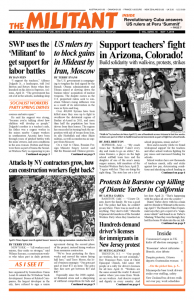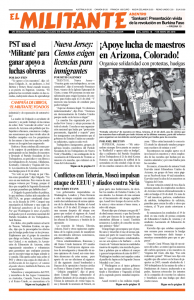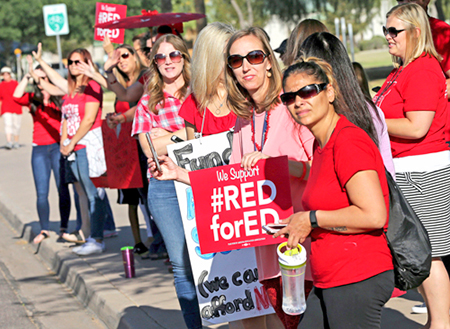SUPERIOR, Ariz. — “My coach wears her ‘RedforEd’ T-shirt every day and wants to go on strike,” Korinna Romero, a player on the high school softball team here and the daughter of one of the area’s many copper miners, told members of the Socialist Workers Party here April 21. “I agree with her. They are doing the right thing. The state has cut a lot of school programs, music and art.”
Here and in nearby Globe we found widespread support for the teachers and other school workers fighting for pay raises and increased funding for schools.
School workers here saw thousands of teachers march, rally and strike against low pay, deteriorating conditions and shrinking school funding in West Virginia, Kentucky and Oklahoma. They organized themselves, won allies and made gains.
In March music teacher Noah Karvelis initiated Arizona Educators United, a rank-and-file group whose Facebook page rapidly grew to 49,000 members. Karvelis got the idea from what teachers had done in West Virginia.
In a three-day statewide ballot last week, Arizona school workers discussed, debated and voted overwhelmingly to walk out April 26. Of the more than 57,000 teachers, custodians, bus drivers, cafeteria workers, crossing guards and others who cast a vote, 78 percent were in favor.
The results were announced at a joint news conference by AEU and the Arizona Education Association union April 19. “This is undeniably and clearly a mandate for action,” union President Joe Thomas said.
Karvelis said they were waiting a week to start the strike because “we need to give our communities time to prepare.” Teachers, other school workers and their supporters are organizing to use the time to make the strike as united and successful as possible.
When Cami Winsor, a daughter of a copper miner, heard that coal miners backed the teachers in West Virginia, she said, “That’s really cool.” Winsor told us proudly that when she was 10 she walked the picket line when her father was on strike. In 2005, some 1,500 workers at Asarco copper mines and smelters in Arizona beat back company attempts to impose cuts to wages and benefits in a four-month strike.
They won a new contract in 2017, after a bitter four-year fight with company bosses.
Governor tries to divide workers
At a March 28 rally of thousands outside the state Capitol in Phoenix, Karvelis got roaring approval when he presented the Arizona Educators United’s demands. They include a 20 percent pay raise for teachers, raises for all other school workers and restoration of school funding to its 2008 level, which would require $1 billion more in the state budget. The Arizona government spends $924 less per student in inflation-adjusted dollars today than it did 10 years ago.
“Site liaisons” — volunteer organizers — have been assigned by Arizona Educators United at 1,000 schools, to coordinate the work of the group and the union. On April 11, more than 100,000 school workers, students, parents and supporters participated in walk-ins at schools across the state.
The following day Gov. Doug Ducey announced a proposal to the legislature to raise teachers’ wages by 9 percent this year and 5 percent in each of the next two years. But Arizona Educators United and the union dismissed this as an attempt to sow divisions among workers and weaken their fight. Ducey didn’t set raises for other school workers or propose increased funding for schools.
“If our district chooses to walk out, I will,” Ruth Vining, a Jack Daley Primary School teacher in Thatcher, 74 miles southeast of here, told the April 23 Eastern Arizona Courier. “We’re apprehensive because we don’t know the repercussions. What we do know is that it has to be all or none, we have to be unified.”
Walk-ins were organized on the three mornings before April 26. Rank-and-file leaders took initiatives to build the social movement necessary to broaden support and to blunt opposition from local school authorities. Experiences from the West Virginia strike and past copper mine battles clearly weighed in.
Organizing to take care of students
The Sahuarita Sun reported April 21 on a meeting by five Arizona Educators United liaisons with 50 parents and teachers to discuss plans to feed and take care of the students. The town south of Tucson is near Asarco and Freeport McMoRan mines.
They spent two hours discussing what will happen if the Sahuarita Unified School District closes down. Barb Tingle, a kindergarten teacher, reported that churches, community organizations, school board staff, teachers and volunteers are lining up to make lunch boxes and sack lunches for the many students who depend on the schools’ breakfast and lunch programs. One church in the area has agreed to be a drop-off location for food and gift card donations and a “delivery squad” has been formed to reach students in Sahuarita and outlying areas.
Danielle Pack, a reading specialist, said a Facebook page has been set up for volunteers willing to watch children and for those in need of having their children watched. By the time of the meeting more than 570 people had joined the Sahuarita Walk Out Childcare Network.
Several of the participants asked how they could support the school workers. The liaisons encouraged them to donate food, volunteer for child care, wear RedforEd T-shirts, make signs and participate in the events organized during the walkout, including the daylong rally planned for April 26 at the state Capitol.
This area in the southeast has some of the biggest copper mines in the country. Freeport McMoRan and Asarco operate eight mines and smelters in the state, employing some 9,000 workers.
Pilar Ramos from Globe, a longtime smelter worker and former member of the United Steelworkers union, described the conditions Mexican workers faced in the mines when he was hired in the 1960s, including seeing a “white only” sign on the bathroom. He participated in several union battles over the years.
Ramos described the militant three-year-long strike copper workers waged against the Phelps Dodge Morenci mine bosses that started in 1983. It ended with the decertification of all 13 unions. Today Freeport owns the Morenci mine, the state’s biggest copper mine, employing 3,300 people. Like all of Freeport’s Arizona mines, it is nonunion.
“Companies have changed hands many times,” Ramos said. “Big business doesn’t care about the workers.”
Emma Johnson and Betsey Stone contributed to this article.


